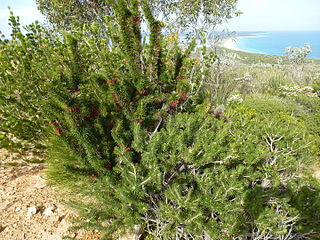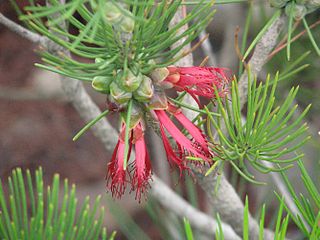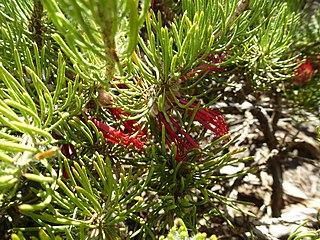
Calothamnus pinifolius, commonly known as dense clawflower, is a plant in the myrtle family, Myrtaceae and is endemic to the south-west of Western Australia. It is an erect shrub with dense foliage and clusters of red flowers, partly immersed in the prickly foliage, between July and January.

Calothamnus sanguineus, commonly known as silky-leaved blood flower, is a plant in the myrtle family, Myrtaceae and is endemic to the south-west of Western Australia. The Noongar peoples know the plant as Boolgalla. It is an erect to spreading shrub with short, cylindrical leaves and red or white flowers with an unusual arrangement of stamens, often flowering in autumn, winter or spring. It was the first of its genus to be formally described.

Calothamnus graniticus, commonly known as granite claw flower, is a plant in the myrtle family, Myrtaceae and is endemic to the south-west of Western Australia. There are two subspecies, both of which have been classified as "near threatened". It is an erect, rounded shrub with pine-like, dark, grey-green foliage and usually bright red flowers. Calothamnus graniticus subsp. graniticus occurs in the Leeuwin-Naturaliste National Park and is the floral emblem of the nearby city of Busselton.

Calothamnus villosus, commonly known as woolly net-bush or silky net-bush, is a plant in the myrtle family, Myrtaceae and is endemic to the south-west of Western Australia. It is a tall shrub, often forming thickets. It has thin, cylindrical leaves and blood red flowers for many months of the year. It is superficially similar to Calothamnus quadrifidus but can be distinguished from that species by its flowers which have five stamen claws compared to the four of C. quadrifidus.
Calothamnus accedens, commonly known as Piawaning clawflower is a plant in the myrtle family, Myrtaceae and is endemic to the south-west of Western Australia. It was first formally described in 1984, declared extinct in 1992, rediscovered in 2004, removed from the "extinct" list in 2013 and found to have a population of at least 25,000 in 2015. It is a small erect shrub with crowded hairy leaves and red flowers. In 2014 Craven, Edwards and Cowley proposed that the species be renamed Melaleuca accedens.

Calothamnus brevifolius is a plant in the myrtle family, Myrtaceae and is endemic to the south-west of Western Australia. It is a small, highly branched shrub with almost cylindrical, pointed leaves and red flowers in summer. In 2014 Craven, Edwards and Cowley proposed that the species be renamed Melaleuca hawkeswoodii.
Calothamnus borealis is a plant in the myrtle family, Myrtaceae and is endemic to the south-west of Western Australia. It is a small, erect shrub with crowded, cylindrical leaves and red flowers. It grows in sand surrounded by spinifex or heath. In 2014 Craven, Edwards and Cowley proposed that the species be renamed Melaleuca aquilonia.
Calothamnus arcuatus is a plant in the myrtle family, Myrtaceae and is endemic to the south-west of Western Australia. It is a shrub with prickly, cylindrical leaves with a slight, upward curve and bright red flowers in small groups near the older leaves.
Calothamnus cupularis is a plant in the myrtle family, Myrtaceae and is endemic to the south-west of Western Australia. It is a similar shrub to Calothamnus formosus but has larger flowers and fruit.

Calothamnus hirsutus is a plant in the myrtle family, Myrtaceae and is endemic to the south-west of Western Australia. It is a small, spreading shrub with prominent hairs on the leaves giving them a smoky appearance. The flowers are deep red and are usually in dense clusters between the older leaves.
Calothamnus macrocarpus is a plant in the myrtle family, Myrtaceae and is endemic to the south-west of Western Australia. It is an erect shrub with bright red flowers in spring and large, almost spherical fruit. It has a limited distribution near Hopetoun.
Calothamnus phellosus is a plant in the myrtle family, Myrtaceae and is endemic to the south-west of Western Australia. It is a tall, spreading shrub with needle-shaped, prickly leaves and bright red flowers with five stamen bundles.
Calothamnus quadrifidus subsp. petraeus is a plant in the myrtle family, Myrtaceae and is endemic to the south-west of Western Australia. It is similar to other subspecies of Calothamnus quadrifidus except that its leaves are linear and somewhat rough and scaly and the stamen bundles are relatively long.
Calothamnus quadrifidus subsp. quadrifidus is a plant in the myrtle family, Myrtaceae and is endemic to the south-west of Western Australia. It is similar to other subspecies of Calothamnus quadrifidus except that its leaves are circular in cross section and the leaves and flower cup usually have a sparse covering of long, soft hairs.

Calothamnus robustus is a plant in the myrtle family, Myrtaceae and is endemic to the south-west of Western Australia. It is an erect shrub with cylindrical leaves and small clusters of red flowers in spring, followed by fruits with have two prominent lobes.
Calothamnus roseus is a plant in the myrtle family, Myrtaceae and is endemic to the south-west of Western Australia. It is a shrub with needle-shaped, prickly leaves and pink flowers with four stamen bundles.
Calothamnus scabridus is a plant in the myrtle family, Myrtaceae and is endemic to the south-west of Western Australia. It is a shrub with needle-shaped, prickly leaves and red flowers with four stamen bundles.
Calothamnus torulosus is a plant in the myrtle family, Myrtaceae and is endemic to the south-west of Western Australia. It is sometimes an erect, sometimes prostrate shrub which has pine-like leaves and usually red, 4-part flowers. It is similar to Calothamnus sanguineus except that it has larger fruiting capsules.

Calothamnus tuberosus is a plant in the myrtle family, Myrtaceae and is endemic to the south-west of Western Australia. It is a stiff, prickly plant with cylindrical leaves and red flowers, growing near or often on granite boulders. It has a lignotuber and tuberous roots.

Calothamnus validus, commonly known as Barrens clawflower, is a plant in the myrtle family, Myrtaceae and is endemic to the south-west of Western Australia. It is an upright or rounded shrub with stiff, cylindrical but not sharply pointed leaves and red, 4-part flowers. The common name derives from the location, West Mount Barren, where it was found by Spencer Moore, the author of its formal description. It is commonly cultivated and has sometimes escaped from gardens in Western Australia.


















